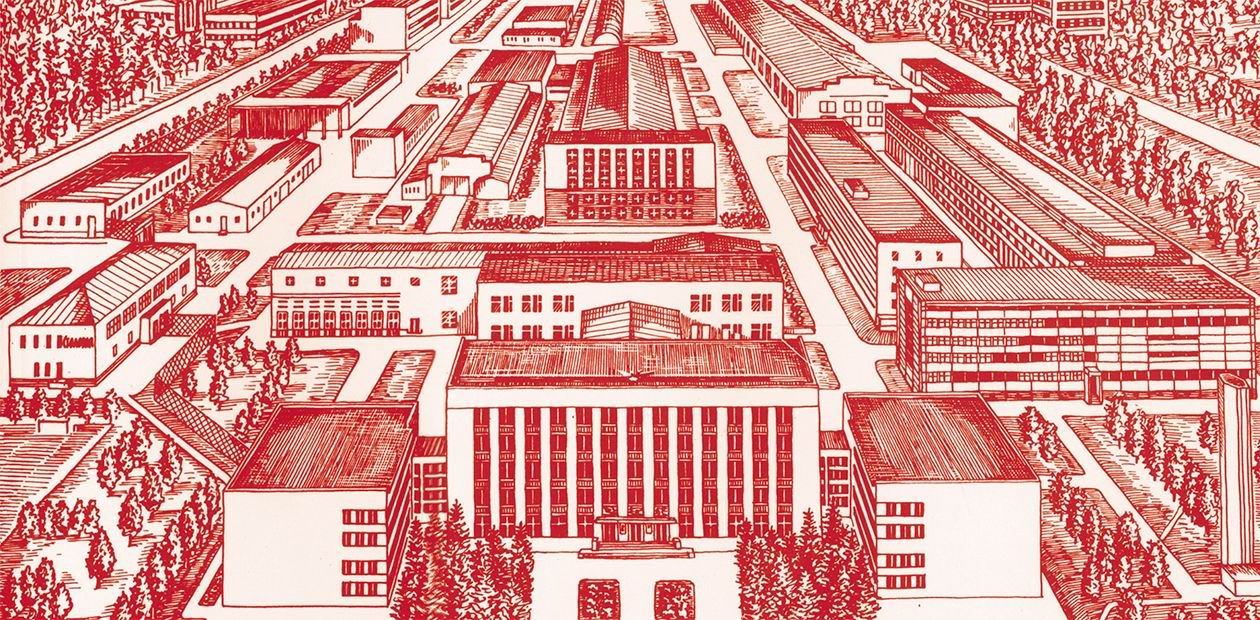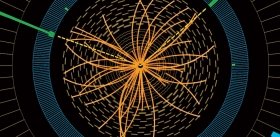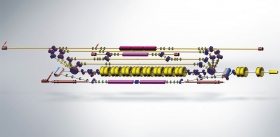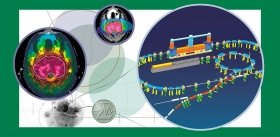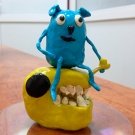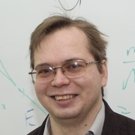Excursion over the "State" of the Institute of Nuclear Physics
The G. I. Budker INSTITUTE OF NUCLEAR PHYSICS (INP) of the Siberian Branch of the Russian Academy of Sciences was founded in 1958 on the basis of the Laboratory of New Acceleration Methods of the Moscow Institute of Atomic Energy headed by I. V. Kurchatov. Today INP is a major world-class center of research in high-energy physics, plasma physics, controlled nuclear fusion, synchrotron radiation, and related areas of applied physics.
Academician G. I. Budker, the founder of INP, headed the institute for twenty years. After his death up to the present day, Director of INP is Academician A. N. Skrinsky. In addition to research laboratories, the institute has a powerful pilot production and employs about three thousand people, of which approximately five hundred are engaged in scientific research. The institute hosts chairs of the Novosibirsk State University and Novosibirsk State Technical University, where more than two, hundred students and candidates for a master’s degree (undergraduates) are trained annually.
The Institute is located in Novosibirsk Akademgorodok, (Academician Lavrentiev Avenue, 11)
Only an outsider can fully app-reciate the uniqueness and peculiarity of the institute. As usual, great things are better seen only at a great distance. However, the point here is not the scales, although with its staff of three thousand employees, the institute today is indeed the largest research institution in the country — during the difficult years of social and economic disruptions, it lost only 10 % of the staff it had before perestroika. By the end of the 1980s, there were a few tens of research institutes of the same or larger size — and where are they now?
The peculiarity of the institute shows up even in its name. The Institute of Nuclear Physics is engaged primarily in the so-called high-energy physics rather than nuclear physics. Knowing people say that the legendary father-founder of INP G. I. Budker “calqued” the name of the Alma Mater, the Kurchatov Institute of Atomic Energy, to ensure a relatively comfortable life for his extremely peaceful child. Recall — these were the 1950s…
In the everyday life of the institute there is a rational organizing principle. What is surprising here is not con-trast, but unusual simplicity and con-sistency in the organization of the work process. Following the tradition established by G. I. Budker, meetings of the institute’s Academic Council are still held at the famous Round Table, on which there are polished coffee pots (a rarity now) with freshly brewed real coffee, and no “instantan ersatz”! The doors of this hall are open for anyone…
Round tables, large and not so-large — not simply furniture, but a material embodiment of the system of mutual relations — are commonly found in the institute. By hearsay, they are made somewhere in the institute’s workshops. And what one will not see here are office girls in the offices of the institute’s heads, as well as the offices themselves. In addition, there are no massive door plates with names and titles, even in the Director’s office. In view of the oncoming Director’s anniversary, visitors to the institute have increased in number — and a kind man pasted sheets of paper with printed names on the room doors…
In the office of Vice-Director N. A. Zavadskii, one can see a certificate awarded by the Novosibirsk Region Administration and the Regional Tax Office to INP — a research institu-te! — as the best taxpayer in 2004. This ceases to be surprising when one learns that a four-fifths of the considerable institute budget is its own earned income. Today, physicists have to satisfy their curiosity and simultaneously maintain the national prestige largely at their own expense.
At the same time, the huge pilot production department of INP makes products other than saucepans and TV sets. Unique scientific and small-batch commercial facilities are bought by China, Korea, Germany, Switzerland… Of course, one may regret that such a considerable part of the productive potential of the institute is spent to support science abroad. At the same time, we cannot help but feel pride in the institute which earns a living without selling raw materials and technologies. Very few people in today’s Russia can boast of it!
The institute invests most of the earned money in the most important and “grateful” resource — people, its greatest wealth, without which any unique facility is an expensive heap of scrap metal. As a result, the institute has no brain drain and no generation gap. Young pleasant and clever faces are often seen in the accelerator control rooms and underground passages of INP.… Of course, an outsider does not see all problems and difficulties that inevitably arise in the life of any organization, even a successful one. At the same time, an outsider can easily see the main thing: the spirit reigning in the institute, which has kept features of the almost forgotten atmosphere of young Akademgorodok and the particular corporate culture… Meeting with such undeclared and obsolescent purity of thoughts fed by big science and supported by modern competent management cannot leave anybody indifferent.
Here one becomes convinced that the tree planted almost 50 years ago by loving and skilful hands has grown, got stronger, and learnt to stand up to the elements, bearing fruits and sheltering young shoots in its crown. May the INP employees forgive me the lofty style, which is so unusual for this institute, but may the fruits of their tree of knowledge never be bitter!
Editorial Staff
EXCURSION to the ELEMENTARY WORLD
Foreword. In the beginning, such excursions were casual (guided excursions were not coordinated). The Secretary for Science asked someone to be a guide for the next group of visitors. This continued for many years. Eventually, the time came when it became clear that, with increasing number of visitors, one person and his friendly relations with his coworkers could not be the “mainstay” of this good deed. A structure was needed.
The payment of voluntary guides was agreed with the institute’s administration, and a search for voluntary guides began. At present, there are about thirty young people at the institute who can conduct excursions at nine large facilities. Each year, about a thousand of senior pupils take part in such excursions (come to the institute for a guided tour).
I am standing at the entrance and waiting for guests. They called the day before yesterday — School No. 86, I know there is a good teacher of physics there, and I was told that there would be about fifteen people: all interested pupils from the senior classes.
Finally they appear — My God! — they are twenty, of which more than a half are girls. When they are passing through the check point, I ask them: “Why are there more people?” The answer is: “They want it badly.” Well, twenty people are not so many and need not be divided into two groups. Yet, it is not clear why so many girls come to see the institute, whereas at the Physical Department of Novosibirsk State University they are only ten percent of students? It is a puzzle to me. I lead them to the conference hall. The lecturer is ready. Everyone take their seats. Light turns off, and a picture with an image of the institute’s facade appears on the screen. “I am glad to welcome you in the main conference hall of the Budker Institute of Nuclear Physics of the Siberian Branch of the Russian Academy of Sciences, or simply INP. INP is a unique institute. It is the largest academic institute in the country.”
It is known that in medicine, psychology, and education issues, everyone is an expert. Unfortunately, as regards nuclear physics (as well as high-energy physics and the physics of elementary particles) most people are complete know-nothings.
One can therefore understand the excitement the magazine staff representatives felt when first crossing the threshold of a colossus of high physics, the Institute of Nuclear Physics of the Siberian Branch of the Russian Academy of Sciences. Fortunately, we were lucky — we had a diligent guide, researcher Evgenii Baldin. We suggest that our readers also join him in one of the review excursions — which are quite common in this great scientific “state”. In the next issues of our magazine, his young colleagues will “taken the baton” and lead further excursion
I have heard this introduction more than once. The institute where I am working bears this name, but nuclear physics in itself is not present here. It was given its name at the time when the field of science in which the first team headed by Gersh I. Budker was going to work only emerged. This is elementary-particle physics, or simply EPP.
“The most surprising discovery of the last century is that atom nuclei consist of nucleons — neutrons and protons, and those, in turn, consist of quarks. Together with electrons, quarks form the basis of the world, being elementary building blocks that comprise matter, according to current concepts.
1966, G. I. Budker*:
“Charged particle accelera-tors are microscopes of modern physics. <…>… We can judge about the structure of the object being observed by the pattern of scattering of a particle beam on it: light quanta in an optical microscope and high-energy particles in an accelerator… <…>The basic object of research for modern high-energy physics is elementary particles. Accelerators are used not only to study the particle structure, but also to generate these particles. The number of known particles increases every year, together with an increase in the accelerator energy. The ultimate goal of these studies is to develop the theory of nuclear forces and elementary particles, whose importance for science and the practice of mankind cannot be overestimated.
Among some physicists there is a strong illusion that this theory can be created in a speculative way… The experience of physics has shown that this almost never happens. <…> The creation f the theory of elementary particles… requires experiments at energy exceeding the modern capabilities. The energy of the particles produced in accelerators has grown in a geometric progression in recent decades… <…> However, this magnificent progress has been hampered by two serious problems. The first… is due to the fact that modern accelerators have reached huge dimensions and the cost of the largest of them is not affordable even for large states… <…>
The second difficulty is of fundamental nature. When the energy of an incident particle exceeds the energy of rest of the particle being investigated, most of the energy is spent for the motion of the common center of inertia of the two particles, and only its small fraction is spent for their relative motion. However, it is this fraction that determines the limiting mass of the new-born particles and the possibility of studying their structure… <…>… In order to avoid such an unfavorable transition from the laboratory coordinate system to the system of the center of inertia, the idea suggests itself to align these systems by directing the particles toward each other with equal momenta…”
*Uspekhi Fizicheskikh Nauk, vol. 89, no. 4, 1966
Just think of it, everything we see consists of only three building blocks (the electron and two quarks: the upper and lower ones). For many centuries, chemistry has attempted to understand the world that is based on this simplicity. These and the remaining elementary blocks — at least nine more particle kinds (the muon, the tau lepton, three kinds of neutrino, and other four quarks, ignoring antiparticles and interaction carriers) — are the objects of elementary-particle physics.
In order to understand how particles behave, it is necessary to produce particle detectors to count each photon that leaves the experimental region. Electronics should be brought to perfection to measure the time intervals of a few hundred picoseconds. This motivates a search for fundamentally new methods of interaction with the real world. The search leads to experience.
Story told by Michail A. Sheromov, INP senior researcher:
This plexiglas cube retains tracks of a rare form of matter — high-energy electrons. The cube was placed on the path of a beam of electrons from an accelerator with an energy of several MeV, which was sufficient for the electrons to penetrate inside. Electrons are charged particles; therefore, having got into electrically nonconducting plexiglas, they remained trapped there. A fairly large internal charge formed. Touching now the cube with a spike would produce a powerful electric field, leading to breakdown. (St. Elmo’s fire has the same nature — the mast tops of ships glow during thunderstorms). Our cube was accidentally brought into contact with a belt buckle — an automatic breakdown occurred: the cube began to sparkle, and a quaint tree formed inside it. Fortunately, everything turned out well — the charge was not too large
A little imagination and a bit of patience, and we get a low-dose digital X-ray facility that provides complete scanning of a person within a few seconds. Since we are able to count each photon, the dose received during the exposure is almost a hundred times lower than that in conventional fluorography. If the dose is slightly increased, it becomes possible to scan even cars. The major efforts of the team of developers are currently being directed toward entering the world market of examination facilities used at airports. The INP device has a lot of advantages: the dose is lower than that passengers are exposed to during the flight (with increasing height, the atmospheric protection becomes weaker, and during a long flight passengers receive the annual “permissible” radiation dose); undressing is not required — one enters a cabin and everything (even what is hidden in the stomach) is visible on the screen because of a high contrast of the image. Such facilities cannot be developed from scratch. Experience is necessary, and it is only accumulated in attempts to solve an almost unsolvable problem regardless of the resources available, because it is impossible to predict exactly what will be useful later.
“It is difficult to study elementary particles. They cannot be felt by hands or with tweezers (they are smaller than atoms) and cannot be seen with a microscope; they even cannot be stored for a long time: they perish or fly away. Therefore, researchers accelerate stable particles (electrons, protons, or positrons) almost to the speed of light, make them collide, and observe what is generated and how it behaves. Electrons and positrons are produced and accelerated in setups called accelerators.
The accelerator’s younger brother is the usual TV set, in which an electron beam is accelerated and displayed on the screen. As a result, we see a luminous point of a particular color depending on where the electron beam hits the screen. In the accelerator, however, the energy of the beam is a few million, or even billion, times higher. At first sight, it is not clear where such energies can be used in national economy.
Indeed, very large accelerators are very expensive tools, but the creation of such machines allows the technology and theory to be brought to perfection. The beam sizes in the machine are smaller than a needle. In our VEPP-4M accelerator, which is by far not the largest in the world, the beams should travel a distance of about four hundred meters to collide. Such “needles” collide with each other at a frequency of one million times per second, and their speed differs from the speed of light only by a few ten-thousandth of a percent. During their life, these “needles” cover the distance from the Sun to Pluto.
The fact that we are able to develop such facilities enables our institute to participate in the development of really big machines for foreign scientific associations — first class tools necessary to gain an insight into the world. For example, a few hundred magnets and superconducting busbars were produced for the Large Hadron Collider, which is under construction at CERN (the leading center for particle physics research in Europe) on the border of Switzerland and France. For this, INP was awarded the “Golden Hadron” Award.
Smaller industrial accelerators are also in strong demand, though in a narrow segment of the market. Recently, however, we have faced a severe competition from Japan and China, where the governments have allocated enormous resources to develop accelerating technologies. Yet, we still stand and produce accelerators for production waste disposal, mass sterilization of medical equipment and materials, proton therapy of cancer, and even for grain handling at ports (which is much better than grain treatment with phosgene).
“Plasma physics is another important area of research that has long being developed at our institute”.
The fact that plasma amounts to more than 90 % of visible matter in the Universe leads one to study thoroughly this fourth state of matter (in this state, atoms break up into separate electrons and nuclei). One of the main goals of plasma research is thermonuclear power engineering. This year, a decision was made to construct the world’s first thermonuclear reactor (ITER) in France.
The facilities available at the institute are not designed to generate power. If, during an excursion, someone asks INP young employees working on plasma facilities: “What is needed in order that the facility can produce thermonuclear power?” — they hesitate and answer: “If the length of the facility were two kilometers…”. And now the facility is only fifteen meters long. But, perhaps, this is for the better — this is a research facility, but not an operating power plant.
“On exposure to plasma, materials can become superhard, ultrastrong, and ultrareliable. All modern processors are manufactured using plasma technologies. A plasma jet can cut thick metal or accelerate spacecrafts.”
There are real projects, but to implement them one should study the nature of plasma. For example, on the GDL plasma facility, research is underway to develop a superpower neutron source. It can be used, in particular, as a component of a safe fusion reactor. By the way, during excursions, plasma facilities enjoy particular popularity: they are smaller than accelerators, but are in full view and vary in design.
“Electron and positron beams moving at high velocities in the magnetic field are powerful sources of synchrotron radiation (SR), which is widely used for experiments by specialists in various areas of science and engineering”.
Synchrotron radiation is what hinders the work of accelerator specialists since it carries away part of the energy that has just been pumped into a particle beam with great difficalty. At the same time, for synchrotron specialists, this radiation is actually daily bread.
Experts in a great variety of fields deal with synchrotron radiation! Explosion researchers study the development of an explosion: they shoot a real film where the frame duration is a millionth of a second. Biologists irradiate something, and then experience a child-like joy: they say that there even have been attempts to detect cancer from hair structure. Among them are even limnologists, who study lakes, investigate silt layers from the bottom of Lake Baikal and Lake Teletskoye to look back into the past to see what the climate was like long ago.
On our excursion today, we will miss the free electron laser (the Siberian Center for Photochemical Research) — a unique facility developed at our institute and housed in a separate building outside INP. This is, in essence, an accelerator that generates far-infrared radiation and can be used in various applications. There are projects on commercial devices based on this facility. We have now launched only the first stage of the project.
“Fundamental science brings new knowledge for mankind. At present, nobody knows particular applications of this knowledge. However, all advances of modern civilization have been made possible thanks to basic research performed 50—100 years ago”.
There is an opinion that Russia does not need basic research, that we can live on oil and gas. It is silly to think so. First, oil and gas industry employs only half a million people. Second, this cannot last forever. The Soviet Union collapsed during the first sharp drop in oil prices. The way things are going, we will not survive the next landslide of prices.
To be an advanced technological country, we need institutions that train qualified specialists. It is fundamental science that cultivates competent research manpower and provides new ideas. Commercial companies (except may be for IBM) do not spend money on research and personnel training: this is not profitable and it is cheaper just to buy. But suppose there will be nowhere to buy (nobody sells), what will they do then?
That is all. The lecture is over. Now I will bring these children to my facility and demonstrate them everything that they have already seen on the screen. I will be asked about mutant rats and will answer that “they are not found here”. Girls on high heels will have my careful attention: some stairs to the facilities are not meant for high-hilled shoes. Safety during the excursion is the main thing.
It happens that some children ask really interesting questions — these are our future research colleagues. It is for them that the excursions are organized, and we hope that in the future some of them will conduct excursions for school children to show their own facilities.
Yury A. Rogovsky, post-graduate student, senior laboratory assistant, Laboratory 11
We present our future authors — young scientists.
They will tell you about unique setups and investigations at the Institute of Nuclear Physics (INP), Siberian Branch of Russian Academy of Sciences
I was born in 1982 in Kokchetav, Kazakhstan. I went to school like all children, and had an inquiring mind. My father was a mechanical engineer, and from childhood I saw many big books with formulas and heaps of papers full of calculations. I always asked my father to tell me something interesting. I remember how we heated water in a closed test tube, and the cork “shot”. And once we made a generator, which consisted of a horseshoe-shaped permanent magnet and a frame with a hand drive rotating in it. It certainly could not light the flat, but the pocket torch lamp light was burning bright. We also had a self-made acting incubator, which was almost the same as that in the book “Dreamers” written by Nikolai Nosov.
At school, I liked, besides literature lessons, exact sciences, especially geometry. I always liked chemistry and physics because of experimental work. I studied at the musical school for more than ten years (five years of the compulsory course, and the other five years just for myself).
Already before my final school years I took part in city and regional Olympiads. When I learnt that a traveling commission from Akademgorodok came to our city, I decided to take part in the interview. As a result, I became a participant of the Summer School. Then I studied at the Novosibirsk School for Physics and Mathematics and the Physical Faculty of Novosibirsk State University. Lectures in physics about the phenomena of relativistic time dilation and length contraction, incomprehensible at that time, as well as about the components of nucleons, i. e. quarks and leptons, were of great interest to me.
For specialization, I chose the Chair of Accelerator Physics (INP) to do what was of great interest to me (I longed to know how to make the electron and positron collide and what would come out of it, and many other things that still remained uninvestigated). Although it is extremely interesting to be engaged in physics research in general, even if not in concrete specialization. This is, however, rather difficult, because to study something new, much time and effort are required. But I am sure that this is worth while. Therefore, after graduating from Novosibirsk State University I am working at the Institute of Nuclear Physics.
I always remember the following words my grandfather said to my father, “Study and learn, my son, and I’ll help you where I can”. And now my father said the same words to me.
Tatiana V. Rybitskaya, post-graduate student, senior laboratory assistant, Laboratory 5—1
How did I happen to be working at the Institute of Nuclear Physics? It isn’t surprising at all that I am a physicist: my family are a dynasty of physicists. My parents are physics teachers, now my younger sister Ira is also specializing in physics. I do not remember our parents making us study as we were children, but somehow we showed a bent for exact sciences. Simply we succeeded in them better than in anything else. Maybe this was inherited.
And then it was quite easy: Olympiads, School for Physics and Mathematics, University… I remember my mother trying to persuade me to study at the Mathematical Faculty, and Ira at the Economical Faculty, but she did not try hard, because it was clear what we would do.
At the university I heard about the Institute of Nuclear Physics, about its large complex facilities. Therefore, as I was a third-year student for my assignment I chose a chair at INP. For me, it was interesting to find the limits of my capabilities. And although now I understand how much one needs to know to be engaged in physics research, I do not regret my choice. The most important in science is that it has no limit to development. It isn’t likely that some time all phenomena of nature will be completely understood. This is interesting, because one can always discover something new and unknown…
Andrei V. Anikeyev, senior researcher, PhD in Physics and Mathematics, NSU teacher
In 1990, being a second-year student of the NSU Physical Department, I first came to the Gas-Dynamic Trap (GDT) setup to prepare my term paper. I liked it very much, and I remained there. I got assignment to the Chair of Plasma Physics. After graduating from Novosibirsk State University I entered INP post-graduate course, and finished it early (half a year before the end of the course), defending my thesis in May 1995. I was winner of various competitions for young scientists, winner of the Budker Prize of the Siberian Branch of Russian Academy of Sciences (1996), a bursar of the Alexander von Humboldt Foundation, etc. Now, I am a research leader in the GDT-team (Gas-Dynamic Trap), a teacher at the Chair of Plasma Physics (NSU), and a scientific adviser of students.
Andrey A. Shoshin, junior researcher, Laboratory 10
I was born on October 1, 1978, in Potsdam, German Democratic Republic. My father was a serviceman. So, as I had to move together with my father, by the ninth grade I changed five schools and found myself in Altai. I won the second place at the Regional Olympiad in Physics, and was invited to the Summer School. That is how I became a student of the Novosibirsk School for Physics and Mathematics (NSU Specialized Educational-Scientific Center). After finishing School, I entered the Physical Faculty of Novosibirsk State University. Already in my first year at NSU, I started work at the Laboratory of Experimental Physics headed by A. S. Zolkin. I was engaged in the creation and investigation of the properties of ionic sources and their applications. As I was a second-year student, B. A. Knyazev, head of our seminar, took our group to an excursion to the Institute of Nuclear Physics. I saw the Institute facilities for the first time and understood that I wanted to work here, to study plasma and, in particular, to work at the GOL-3 facility. At the assignment to chairs at the end of the second year, I chose plasma physics. At the beginning of my third year, I came to GOL-3. My scientific adviser was A. V. Burdakov. I graduated from the Physical Faculty with honors, and entered the NSU post-graduate course. Then I became a junior researcher at the Institute of Nuclear Physics. My scientific interests include plasma physics, spectroscopy, the action of plasma on various materials, etc.
Anton D. Nikolenko, researcher, Laboratory 8—0
I was born in Akademgorodok in the spring of 1968, the year of Bardic Festival and the first year of Zastoi (Stagnation). I was a pupil of an ordinary school in Akademgorodok. At the age when I no longer wanted to be a fireman, a cosmonaut, a cook, and a tank driver at the same time, I began thinking of becoming a physicist. I do not like the expression “to follow father’s footsteps”. Simply I always liked this profession. As for higher education, I had no doubts — I wanted to study only at Novosibirsk State University. Although I must admit that if I did not study (by correspondence) at the School for Physics and Mathematics, the training level of an ordinary school wouldn’t be sufficient for my entering NSU. I entered the University and studied there. After the first year of my studies, I was enrolled. This was the time when all young men, and students were not an exception, were called up for military service. The army gave me a lot of negative emotions and much life experience, although it was somewhat one-sided. After the army I returned to NSU as a second-year student. At the end of the third year of my studies, in 1990, I started to do practical work at INP. In the fourth year of my studies, I changed my scientific adviser, the reason for this being my own incorrect attitude towards work. Then I understood that it was time to start working seriously. That’s what I did when V. F. Pendyurin became my scientific adviser. After graduating from Novosibirsk State University in 1992, I continued my work at the Institute of Nuclear Physics, and I am still working there now. In 2001 I worked for 3 months on SPRING-8, the world-largest source of synchrotron radiation, in the NIRO group (Japan). I am mostly involved in metrology in soft radiation and the use of Synchrotron Radiation. Besides Japan, I made business trips to Spain, Switzerland, and Germany. It’s great to do physics research! I like this kind of job. It’s a good work.
Alexander V. Kuzmin, student, senior laboratory assistant, Laboratory 8—1
I was born in Kazakhstan, the city of Pavlodar, and grew up there. First I went to an ordinary school. Then I was a pupil of a School- Lyceum No. 8. Then, as they say, I was given a chance. I participated in a regional Olympiad in Mathematics, attended by people from Novosibirsk, at which I took the good second place. After this, in the summer in my letter-box I found a letter from Novosibirsk to invite me to the Summer School at the School for Physics and Mathematics. I hadn’t been to Russia before. And I got an invitation to such a large city as Novosibirsk! I wanted to go there, but I wasn’t going to stay there.
When I was in Novosibirsk, however, I told my parents that if I were taken in the School for Physics and Mathematics I would remain there to study. And that was settled. There, at the School for Physics and Mathematics, I decided to become a physicist. It was clear to me — I will go to the Physical Faculty. Now, it’s already my sixth year there. It’s both hard and interesting to study there.
The reason for my coming to INP is simple enough: when, at the end of the second year of my study, it had to be decided what chair to choose, all chairs of the Physical Faculty were considered and compared. And INP won: it was known for sure that here we would become “normal” specialists.
Alexander S. Lakhtychkin, student, senior laboratory assistant, Laboratory 8—1
I was a pupil of an ordinary school No. 8 in Iskitim.
I participated in a regional Olympiad in Mathematics (after my winning at a City Olympiad). I was invited to the School for Physics and Mathematics. There, I studied hard and was a good student — and learned a lot. My teacher in physics was Oliver Savchenko. It was he who aroused my interest in science.
I studied at the Physical Faculty. I studied hard and was a good student. By the end of the second year of my studies, it had to be decided where to go. I and my friends visited many institutes and tried to find out the prospects. This was difficult. We asked Oliver Savchenko where to go, and he gave me his advice: laser on free electrons. And that’s where we went. I do not regret…
Alexander N. Matveyenko, researcher, Laboratory 8—1
I was born in 1973. I’ve been a researcher of INP Laboratory 8—1 (Laser on Free Electrons) since 2002. I’m a graduate of the NSU Physical Faculty (1997). In 2000, I graduated from the NSU Post-Graduate Course. In 2004, I got a Medal of the Russian Academy of Sciences for Young Scientists, for the work “Creation of a High-Frequency Accelerator-Recuperator and a Laser on Free Electrons” written jointly with D. A. Kairan and O. A. Shevchenko. On the setup, I am dealing with accelerator physics. I take part in the organization of the work of users at stations.
I’m also a teacher of electrodynamics at NSU. I have two children. I’m a yachtsman. I like to play the grand piano. However, since a grand piano cannot be accommodated in our flat, I play the ordinary piano.


